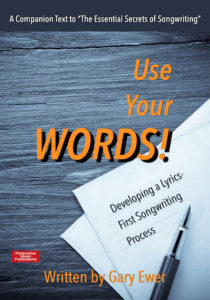How often does sketching become part of your songwriting process? And what does that term mean to you?
In most of the creative art forms, sketching is vital. Whether you’re a novelist creating character sketches, a choreographer sketching out a dance routine, or an artist getting ideas for a new painting, sketching has two main purposes:
- It allows you to practice your technique; and
- It allows you quickly to get a sense of the final product.
I’ve found that songwriters, particularly in the pop genres, don’t do a lot of sketching, at least not in the way we typically use the term. But in a sense (and assuming you broaden the definition of what we usually mean by sketching), any time you sit down to improvise either on your own or with bandmates, you’re engaging in a kind of songwriting sketching exercise.
 If you’re trying to make lyrics-first an important process in your songwriting method, you need to read “Use Your Words! Developing a Lyrics-First Songwriting Process.” Right now, it’s FREE with your purchase of “The Essential Secrets of Songwriting 10-eBook Bundle”
If you’re trying to make lyrics-first an important process in your songwriting method, you need to read “Use Your Words! Developing a Lyrics-First Songwriting Process.” Right now, it’s FREE with your purchase of “The Essential Secrets of Songwriting 10-eBook Bundle”
Improvising takes the pressure off, giving you opportunities to hear what things sound like when you throw them together. Because you’re not forced to use any of the ideas you come up with during an improvisation, you’re free to let your imagination run wild, and that can often be a good thing in the creative process.
But is there room for adding what we might call traditional sketching to the songwriting process? Can you, like an artist with a sketch book, “draw” ideas that eventually become part of your song? What might that actually look like?
Sketching Your Ideas
So what are you able to “sketch?” There are lots of ways that this can happen, so here are three thoughts to get you started — ideas that will require you to get something written down on paper before launching into the actual writing of your song:
- Sketching aspects of your new song’s form. Even if you have only the slightest inkling of what your song is going to sound like, you can make decisions regarding the basic formal design. So on a piece of paper, draw a map that shows the verses, chorus(es) and any other optional section within which you can throw basic ideas down. I’ve written about this before, so take a look at this post.
- Sketching melodies. I’ve mentioned many times that song melodies work well when there’s some sort of relationship between them all. Sometimes the relationship is one of opposites (verses comprised of upward-moving ideas, choruses made up of downward-moving ones, for example), and sometimes they’re all linked by similar rhythms (as in The Beatles’ “Penny Lane”.) If you don’t read or write music, you can still do this by making line drawings of your melodies, and then looking for similarities in their design. My post from this past February, called “Songwriting and Line Drawing” will help.
- Sketching lyrics. Sketching out what you plan to say in your lyric is probably the most common form of song sketching that songwriters do, and it’s a great way to build up your song’s basic vocabulary. Create word lists, and then try throwing words and phrases together to see what happens. Little by little, you’ll find yourself discovering word combinations that will end up in the final version of your song.
Those are three ideas that give you the opportunity to get something written down before you start the songwriting process. But why is that valuable? Why not just get busy improvising?
The working out of ideas prior to properly starting the songwriting process allows you to build up a repertoire of fragments and snippets — a kind of musical vocabulary — that speeds up your songwriting process once you start.
Sketching ideas on paper before starting your actual composing also keeps your musical improvisations focused and purposeful. Improvisation moves from being completely random to being something a bit more directed. Instead of anything being possible, you’ll find that sketching gets everything moving in a particular direction, and ultimately speeds up your process.
Even if sketching simply means coming up with song titles, with a few catchy lines of lyric to go with them, you’ll reap the benefits of adding traditional sketching to your songwriting process. Give it a try!
 Written by Gary Ewer. Follow Gary on Twitter.
Written by Gary Ewer. Follow Gary on Twitter.
 “Hooks and Riffs: How They Grab Attention, Make Songs Memorable, and Build Your Fan Base” shows you how a good hook can make the difference between songwriting success and failure. With great examples from pop music history.
“Hooks and Riffs: How They Grab Attention, Make Songs Memorable, and Build Your Fan Base” shows you how a good hook can make the difference between songwriting success and failure. With great examples from pop music history.











Pingback: 7 Tips For the Beginning Songwriter | The Essential Secrets of Songwriting